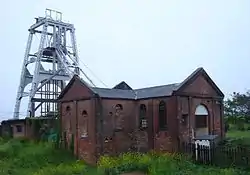Miike coal mine
Miike coal mine (三池炭鉱, Miike Tankō), also known as the Mitsui Miike Coal Mine (三井三池炭鉱, Mitsui Miike Tankō), was the largest coal mine in Japan,[1] located in the area of Ōmuta, Fukuoka and Arao, Kumamoto, Japan.

In 1960, it was the setting for the "Miike Struggle," which was the largest management-labor dispute in Japanese history.[2]
History
Mining began in the region during the Kyoho era, with the Miike mine under the control of the Tachibana clan.[3]
The mine was nationalised in 1872[4] by the Meiji government.[5] The Mitsui zaibatsu took control in 1899.[6]
The mine closed in 1997,[7] with devastating effects on the local economy.[1]
POW Camp
During World War II the mine was used as a prisoner of war camp, referred to as Fukuoka 17. The prisoners were used as slave labor to mine coal.
Labour dispute
From 1959 to 1960 the mine was involved in a much-reported labor dispute led by Itsurō Sakisaka which divided the workers and involved violent strike-breaking actions.
Incidents
In 1963, 458 people were killed by an explosion and the resulting buildup of carbon monoxide. 438 of the deaths were due to carbon monoxide poisoning, and 839 others suffered from the effects of carbon monoxide poisoning, which can cause brain damage.[4] In total, 1,197 of the 1,403 workers died or were injured as a result of the incident. Workers were told by the Mitsui Coal Mining company that a coal-dust explosion in the mine was impossible and were not educated on the potential for gas poisoning. The company had no provisions in place for isolating poisonous gas, in fact, at the time of the explosion, ventilation fans worked to actively spread the gas throughout the mine, leading to more deaths.[4] Only around 200 of the workers knew of the explosion, mostly by hearing it firsthand. Despite making it to the lift, they were told by their officers not to leave and died due to carbon monoxide poisoning. The majority of the workers knew nothing of the explosion. Electricity and telephone communication were lost after the explosion, and initially, no attempts to rescue the workers were made by the company, which stated that it was too risky due to unclear conditions within the mine. As a result, workers remained trapped in the mine for three hours after the company was notified. The inexperienced, ill-advised rescue crews exacerbated the severity of the event by not following the protocols for rescuing victims of carbon monoxide poisoning. Over 200 of the workers who were already suffering from poisoning were sent back into the mines to attempt to rescue others.[4] Of the 939 workers that survived, 839 suffered from serious carbon monoxide poisoning, which resulted in severe, permanent brain damage.[8][4]
On January 18, 1984, an explosion at the mine claimed the lives of 83 workers.
Legacy
The Miike mine was the subject of a Japanese documentary, Echoes from the Miike Mine (2006), directed by Hiroko Kumagai.[9]
See also
References
- Karan, P.P. & Stapleton, K.E. (1997) The Japanese city p.181 University Press of Kentucky ISBN 0-8131-2035-7 Retrieved January 2012.
- Kapur, Nick (2018). Japan at the Crossroads: Conflict and Compromise after Anpo. Cambridge, Massachusetts: Harvard University Press. p. 135.
- Norman, E.H. & Woods, L.T. (2000) Japan's emergence as a modern state: political and economic problems of the Meiji period p.59. UBC Press ISBN 0-7748-0822-5 Retrieved January 2012.
- Industrial pollution in Japan Chapter - 5 The Miike coal-mine explosion
- Norman & Woods, (2000) p.121.
- Karan, P.P. & Stapleton, K.E. (1997) The Japanese city p.9. University Press of Kentucky ISBN 0-8131-2035-7 Retrieved January 2012.
- Workers get the shaft in Mitsui coal mine closure Asahi Shimbun, 18 February 1997
- Kawabata, Tai, "Film mines rich seams of history", Japan Times, 14 August 2011, p. 8.
- Tomoda, Yoshiyuki (November 2010). "Nihon no tankō eigashi to Miike" (PDF). Gengo bunka kenkyū (in Japanese). 22 (2): 21–37.
External links
- Former Miike Coal Mine Miyahara Pit, from Kyushu Tourism Information